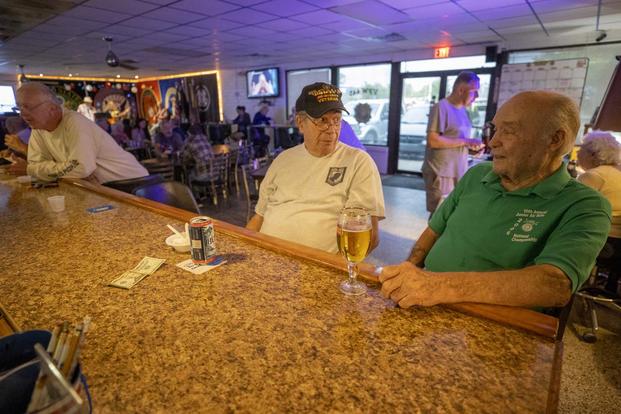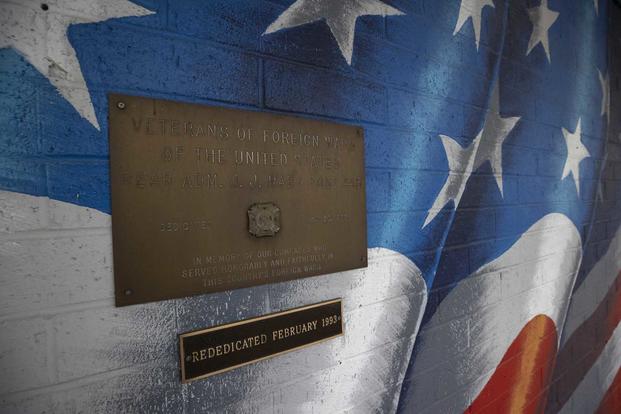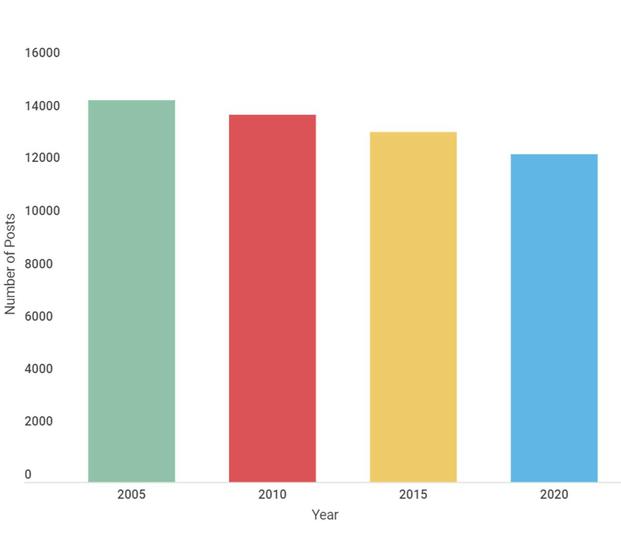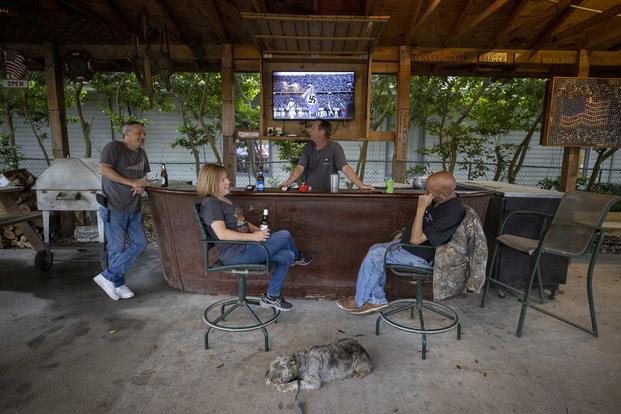Jim Barger's throne at Charleston, South Carolina's VFW Post 445 is the corner barstool, where the 91-year-old Army veteran sits back and sips from a foamy glass of Stella Artois.
It's "Wing Wednesday," the one night each week where the cinder block building tucked onto a side street comes alive. Veterans trickle in for their routine of heavy-handed pours of Jameson or a cold bottle of Bud Light.
Barger, the commander of the post, watches over the scene from the far end of the bar, happy people are here. His organization has fallen on some tough times, especially during the height of the coronavirus pandemic. He stops to scan the wrinkled faces of the regulars, veterans who mostly served in Vietnam and Korea.
Read Next: Staff Shortages and Burnout Topped Challenges for Military Hospitals in Pandemic, Watchdog Finds
Chuck Blankin, the chaplain at the VFW post, comes up to Barger and grips his hand and smiles. Blankin has been a member for 14 years, and openly talks about being shot in Vietnam and the physical and emotional pain he's had to work through since returning home.
To Blankin, the VFW post isn't just a bar: It's a hospital, it's therapy and, more than anything, it's a family.
"If you look up PTSD in the dictionary, my picture is there," Blankin said as he pats Barger on the back, the in-house band taking a break from covers of Jimmy Buffett songs to yell out bingo numbers to the 30 or so graying veterans. "And this guy, he has been there for me."
But VFW and American Legion posts just like Barger's are disappearing.
These posts, often decorated with military flags, dusty plaques honoring community service projects and faded photographs of past members and friends, are woven into the fabric of communities across the U.S. They stretch from the industrial blue-collar towns of the East Coast and rural American South to the ranching communities of the Western plains and agricultural Southwest, serving as safe spaces for veterans, especially those who returned from Vietnam to find a country unready and unwilling to grapple with the costs its young men had shouldered.
The VFW had a record 2.1 million members in 1992. By last year, that number was just a shade over 1 million, meaning it has lost half its members in a generation.

The posts are places where the deep bonds begun in foxholes overseas can be woven stronger, where generations have not only healed but chosen to give back to their communities.
The VFW is a massive organization that has lobbied in Washington on behalf of service members to expand research, benefits and health care for veterans of all ages.
It has fought for Vietnam veterans made weak by Agent Orange, Gulf War veterans who face debilitating symptoms from environmental exposures, and post-9/11 Iraq and Afghanistan veterans whose lungs are heavy from respiratory diseases and cancer from burn pits.
Its buildings host food drives, scholarship programs and blood drives. And, in many places, VFW posts are the only affordable event venue in town, becoming a cornerstone of memories as the backdrop to weddings and retirement parties.
But something is missing. Of all the patrons inside during this particular "Wing Wednesday," Barger noted that no one at the bar served in Iraq or Afghanistan.
The aging membership rolls continue to lose veterans, and the generation of retired service members from two decades of combat this millennium haven't shown up to fill their shoes.
"We've seen a few Iraq and Afghanistan guys come in, but they're young, and they're starting families," Barger said. "We need them."
But many Iraq and Afghanistan war veterans don't see the value in membership in the VFW or its cousin organization the American Legion after they've come back home.
When former Army Sgt. CJ Hardin was stationed in Korea, he would frequent a post outside the base walls because the drinks were cheap and fellow Americans would congregate to take a break from the monotony of base life. He spent three years deployed to Iraq and Afghanistan, and his experiences in the Middle East led him to heavy drinking and intense self-medicating with marijuana to feel numb.
When he got back stateside and settled in Charleston, South Carolina, he thought about becoming a full-time member of the VFW, but a couple visits to posts in the area changed his mind.
"The atmosphere is totally different," Hardin told Military.com, "It's a lot of older guys, it's very cliquey, and they're sitting around talking about their political views. … There's nothing that really reaches out to this demographic. They don't play modern music, they don't have a great beer selection, and nobody [from his generation] wants to just grab a beer and sit there for hours."
Hardin says his generation of veterans, ones who fought in the post-9/11 wars, have found community in other places, and they often prefer experiences like participating in marathons and going kayaking versus sitting in a "dark and dank bar to congregate."
Nationally, VFW and American Legion posts are shuttering their brick-and-mortar halls, and officials from both organizations concede that they're not attracting younger veterans like they want, pointing to one of the major barriers as preconceived stereotypes that joining a local VFW or American Legion is simply paying dues to a musty corner bar.
"We're looking to do things a little bit differently," said Dean Kessel, the chief marketing officer for the American Legion. "And you know, candidly, the membership has declined over the years, and we have to do a better job of being relevant for this next generation of veterans and what their needs are."
Blankin knows, from experience, the organization can offer them a lot more than cheap booze and fried food.
"These younger guys think it's a lot of cigarette smoking and drinking," said Blankin, a 70-year-old Vietnam veteran. "The guys from Iraq and Afghanistan have PTSD worse than any of us do, and they need to talk with people at their VFW and American Legion."
Old Problems, Different Solutions
The American Legion and the Veterans of Foreign Wars have both been around for more than a century and were created to build a community among veterans returning from the horrors of war.
Veterans of the Spanish-American War began forming societies as a way to cope with their trauma and meet fellow service members. By 1899, in Columbus, Ohio, James C. Putnam organized "The American Veterans of Foreign Service" as the predecessor to the modern-day VFW.
Membership in the VFW is available only to those who served in a war, campaign or expedition on foreign soil or in hostile waters and an honorable discharge.

In 1919, men from the American Expeditionary Forces from World War I gathered in Paris, France, to create their organization, the American Legion. It is the largest veteran service organization in the country because of its broad membership qualifications.
Any veteran who has served at least one day of active military duty since the attack on Pearl Harbor on Dec. 7, 1941, and has an honorable discharge is eligible for membership.
Both groups saw their membership peak in the 20th century. The American Legion boasted more than 3.3 million members at its height in 1946, according to an article from The Wall Street Journal, and the VFW had a record 2.1 million members in 1992.
As of today, those figures have been cut nearly in half.
John B. Raughter, a spokesman for the American Legion, said there were 1.76 million members in 2020, the latest data available. Randi Law, a spokeswoman for the VFW, said the organization has just over one million veterans as of last year.
This isn't a new problem. It's one the American Legion and VFW organizations have been facing for years.
A 1972 article in The Wall Street Journal warned that the American Legion was "fading away," noting that Vietnam veterans were not joining the organization at the same rate as those from World War II.
But the decline in American Legion membership is happening at a much steeper rate in the 21st century. In 2005, the organization boasted 2.65 million members. That number decreased by nearly a million in 15 years.

The American Legion still has a large presence across the country, with 12,457 posts as of 2020 -- more than double the number of Walmart shopping stores in the United States -- but younger veterans aren't signing up.
"Like veterans of other periods, it may take a little time for them to join, but we do believe that many of them will join the organization," Raughter said in an email.

The American Legion is congressionally chartered; historically, membership was available only to veterans who served during designated conflicts of war that excluded those who served in the Cold War or covert operations. But in 2019, the LEGION Act was signed into law by then-President Donald Trump, making membership a possibility for more than 4 million veterans who served during those unrecognized eras. Raughter said he hopes this will lead to more people joining the group.
But rigid eligibility requirements are part of why membership is declining at the VFW, Law said. The nature of America's military involvement, of deploying troops overseas during conflict, has shrunk significantly since WWII.
"We've got an all-volunteer force now, where less than 1% of the American population serves the country," Law said. "America isn't making new veterans that are eligible to join the VFW."
The eligibility requirement has been a long-discussed issue among VFW posts.
Robert Skinner, an 83-year-old Army veteran from the Korean War, said changing the requirements would be a saving grace for his group. As the commander of VFW Post 5857 in rural Onaway, Michigan, he has only five members who are active in meetings and planning.
Skinner told Military.com that he needs to fill eight seats on his post's board; if he can't get enough, he'll have to relinquish control of the group to the district post's leadership, effectively closing the building. He speculated that changing the membership requirements might give smaller posts a boost.
"About eight years ago, it started to decline, and since then it's been constant," Skinner said. "I don't see how changing [the eligibility requirements] could make things any worse."
But, ultimately, to fill the growing void being left by older generations of veterans who have passed away, both organizations recognize they need to recruit the latest generations of service members from Iraq and Afghanistan.
Fighting Stereotypes
The VFW conducted a focus group last summer with a group of veterans mostly under the age of 50 and asked them what they knew about their local organizations.
Most labeled VFW posts as little more than bingo halls with bars.
"Those stereotypes are those that we continue to combat," Law said. "I think it's fair to say that veterans enjoyed going into a bar and swapping war stories, and maybe that was the extent of it. But over the years, veterans' desires just have changed drastically."
"I think we're a lot more aware of our image, and now we're focusing on that image to be sure that veterans know we are a representative of all veterans," Law said.
Similarly, the American Legion -- which has been front and center of veterans health issues for decades, such as work on the health consequences of burn pits, Agent Orange poisoning and other ailments from service -- announced this week it was conducting some rebranding by showcasing a more modern logo for its website and social media accounts. It's a small thing, Kessel conceded, but he hopes it shows that the organization is starting to recognize that changes need to be made.
"We really want to sort of signal that we've got some new things going on here to our membership and to our prospective memberships as well," Kessel said.

While the membership in many VFW and American Legion halls skews older, some post commanders are stepping up to the plate to try and recruit younger veterans.
At the start of 2021, VFW Post 2149 in Wood Dale, Illinois, voted to close its doors. The commander of the post had stepped down, and nobody wanted to take on the responsibility of running the group.
Rich Williams, an Air Force veteran from Desert Storm -- the second least-represented group in veterans service organizations -- caught wind of the situation on Facebook and decided to step up. He was sworn in as a VFW member and the commander of the local post 30 days later.
He says he inherited about seven to 10 active members and a solid revenue stream because they have a state gaming license and can provide video poker at the post's bar.
But the main thing Williams wants to change is the culture of Wood Dale's post.
"There's a ton of Afghanistan and Iraq vets out there that aren't coming to the VFW, and that's my goal," Williams told Military.com. "If I get a young guy to come through the door, and he's just curious about it, he's not going to stay if we have 'Bonanza' on the TV."
In both the American Legion and VFW, posts can continue to exist even if they don't have a brick-and-mortar building. Many local organizations meet at churches, schools and recreation centers.
Law said more posts will likely close in the coming years, but because of the national influence of the VFW and American Legion, the organizations will always be present and there to support veterans.
"In a perfect world, the VFW would cease to exist because we would no longer be making veterans," Law said. "But we know that's probably not going to be the case. As long as America is making veterans, the VFW will be here."
-- Thomas Novelly can be reached at thomas.novelly@military.com. Follow him on Twitter @TomNovelly.
Related: New Law Will Allow Thousands More Veterans to Join American Legion







